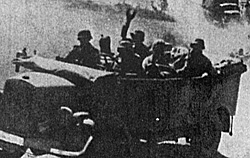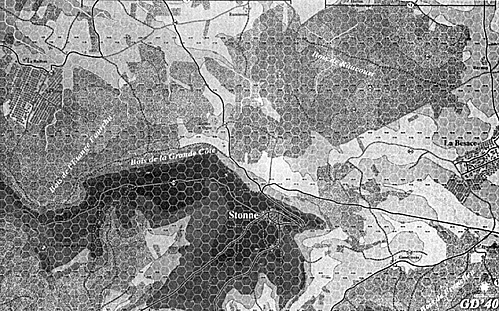 I am writing to update you on a few battles fought here
at the Marine Corps Institute on our Friday Professional Military
Education classes. Since I began these Friday slugfests a few months
ago, I have recruited five new gamers. Only one had previous gaming
experience (ASL). We have played out five battles. I already
recounted the first two (two Matanikau scenarios) in a previous
letter.
I am writing to update you on a few battles fought here
at the Marine Corps Institute on our Friday Professional Military
Education classes. Since I began these Friday slugfests a few months
ago, I have recruited five new gamers. Only one had previous gaming
experience (ASL). We have played out five battles. I already
recounted the first two (two Matanikau scenarios) in a previous
letter.
[Ed Note: see the Letters section of Ops 14.]
Since then, the battles have grown in length and number of units involved.
The next game was the First Counterattack on Kommerscheidt scenario from Objective: Schmidt. I made a mistake as gamemaster. I gave the Germans the 116 Panzer's Recon Bn instead of the Panzer Bn. The recon troops, mounted in their halftracks, were unstoppable. The German artillery suppressed the Americans and then the recon troops conducted consolidated assaults into their hexes. We quickly learned the power of consolidated assaults. The Germans almost wiped out the Americans in three turns and took light casualties themselves.
Battle for Stonne
Next was a complete campaign of GD'40 . We used the optionals. The German had terrible luck in this game. First, they lost two StuG IIIs in the initial attack on Stonne. After their panzers withdrew, they were very slim in the armor department.
The Germans placed I-GD in Stonne, II-GD in the woods east of Stonne and III-GD in the woods west of Stonne; these units implemented prepared defenses. The Sturm Pioneers, with the StuG IIIs attached, were in the woods north of Stonne. The Sturm Pioneers were in reserve.
The French counterattack began on schedule at 0900. The French were extremely lucky on the breakdown table. First, they rolled a six for the 6 GRDI. Next, they rolled three sixes and a four for the four tank companies of 42 BCC and 3-49 BCC. They lost only a few H39s.
The French attack did not go directly into Stonne. They went around to the left, through the woods and into the Huttes d'Ogne area. Along the way, they overran the III-GD Bn in prepared defenses. The German AT guns claimed a couple of tanks before they got blasted. After that, the German infantry was practically defenseless against the French tanks. The French would suppress with artillery or SFAs and then consolidated assault with the infantry riding on the tanks. The 1-67 took moderate losses, but III-GD was wiped out.
Meanwhile, the Germans attempted to release the Sturm Pioneers, with the StuG IIIs attached, from reserve. Lady Luck was against them. It took two hours before they rolled a four or higher. By then, it was too late. When the StuG IIIs got into the battle, they missed three out of four shots and four straight hits by the French eliminated them. (I told you the German luck was terrible.)
The Germans were also unlucky with their optional rolls. They received ammo at 0700, but then hit a dry spell. The panzers did not return until 1200. In contrast, by 1200 the French had received the rest of the 49 BCC, rolling two sixes for breakdown, 2-67, and 45 BCC. The 45 BCC lost 10 tanks to breakdown.
With 42 BCC and 1-67 in the German rear forcing the German mortars to displace, 49 BCC and 2-67 attacked directly into Stonne at 1100. The 45 BCC joined them by 1200.
The I-GD was in prepared defenses in and around Stonne. Using the rest of their artillery ammo, I-GD was able to take out about 12 French tanks and inflict heavy losses into 2-67 before being wiped out.
By 1500, the French held Stonne with 45 BCC and 2- 67. The 1-67, with a company of 42 BCC attached, held the Huttes d'Ogne area. The 2-205, which had sat out the battle in the woods west of Stonne, moved north of 1-67 along the highway, They also had a company of 42 BCC attached. The 6 GRDI, also untouched except for one infantry step lost to air attack, moved to the woods just below the north map edge, on the highway. They received the last company of 42 BCC attached. The 49 BCC was west of Stonne, in reserve. None of the French had defense orders. However, because of prior planning, 1-67 and 2-67 were close to implementing prepared defense orders. They had lost 29 tanks and 8 platoons, and about 20 steps of infantry spread out among 1-67 and 2-67. This loss included the at-start forces in Stonne (8 tanks and 1 & 2-205).
On the German side, 11-GD was sitting, uncomfortably close, in the woods to the right of Stonne in prepared defenses. They were untouched except for 3 steps lost in the initial attack on Storme. They had only two AT guns. I and III-GD were wiped out. Ten AT guns, four 75s and two 105s were gone. Only four platoons of Sturm Pioneers remained. These withdrew to the woods northeast of Storme. The 1-69 was in La Besace. The 4-11-8 was working on orders to move to II-GD and go into reserve. Except for artillery and air strikes, the Germans had to wait for reinforcements and then wait for them to implement orders before they could do anything.
For the rest of the game, 2-67 took heavy losses to artillery until they implemented prepared defense orders. They were down to three platoons. The Germans were unable to mount a counterattack before nightfall. Their armor took too long to implement orders, and as the French still had plenty of artillery ammo (130 HE), the German infantry was afraid to move on their own.
The game ended with a massive French victory, shifted one level for receiving more reinforcements.
This game took two Fridays to complete. Lady Luck definitely favored the French with their early reinforcements and low number of breakdowns. The Germans hung in there till the end, but could not get anything moving.
Objective: Schmidt Campaign Game
Our last game was a campaign of Objective: Schmidt. This marathon game took three days before we reached a decision. We never played the last game day, because the writing was on the wall.
The Americans started out taking Vossenack easily and then pushed across to Kommerscheidt. Here, E-2-112 dug in. Fox and Gulf 2-112 dug in south of the Kaal trail to prevent the remaining battalion of 275 Inf, still sitting in their original position, from interfering with the engineers working on the trail.
The 3-112 passed through and wiped out the Fusiliers, in Schmidt and then dug in. By the next day, all of A-707 had made it through the trail and was in Schmidt. Eight of 112's AT guns were in Schmidt, with four in Kommerscheidt. D-86 Chem was in support of 2- 112. C-707 managed to get 4 tanks into Kommerscheidt. The rest remained in reserve with C-1-112 in Vossenack. A-1-112 took position to block the road along the river north of the Kaal Trail. By midday they were all in prepared defenses except for A-707, C-707 and C-1-112, who were in reserve.
This is when the Germans counterattacked. Two infantry battalions plus the panzers attacked Schmidt from the north. Simultaneously, two infantry battalions (275 Inf finally moved out) hit Fox and Gulf companies south of the Kali trail.
The attack into Schmidt met stubborn resistance from 3- 112 and A-707. P-47s and artillery smashed several Panthers and Mark IVs. Close city fighting claimed tanks on both sides. Eventually, 3-112 and A-707 were practically wiped out. The remnants (1 tank and 1 platoon) withdrew to Kommerscheidt, but the Germans had severe losses. The two infantry battalions were shot up, and only 12 armored vehicles survived. The Germans consolidated in Schmidt.
Fox and Gulf companies, with the help of C-707, repulsed the attack and C-1-112 counterattacked into the woods. Although shot up, C-1-112 succeeded in smashing the remainder of the 275 Inf Div.
The following day, a German infantry battalion and the 116 Recon Bn tried to attack down the river road from the north. A-1-112, with the help of B-1-112 and two platoons of M10s, stopped this attack in its tracks. The Germans did not have room to maneuver in the river valley. D-86 Chem shifted to 1-112 to support this defense.
At this point, the Germans realized that the fresh American reinforcements would be able to retake Schmidt. They conceded.
Lessons
These games have provided an immense amount of enjoyment to all involved. As gamemaster, although I do not get to play, I get to see the planning and strategy used by both sides. My troops' knowledge of the weapons and tactics used has improved considerably. Soon, I hope to participate in an Omaha game and join the ranks of The Omaha Beach Club.

Back to Table of Contents -- Operations #15
Back to Operations List of Issues
Back to MagWeb Master List of Magazines
© Copyright 1994 by The Gamers.
This article appears in MagWeb (Magazine Web) on the Internet World Wide Web.
Other military history articles and gaming articles are available at http://www.magweb.com